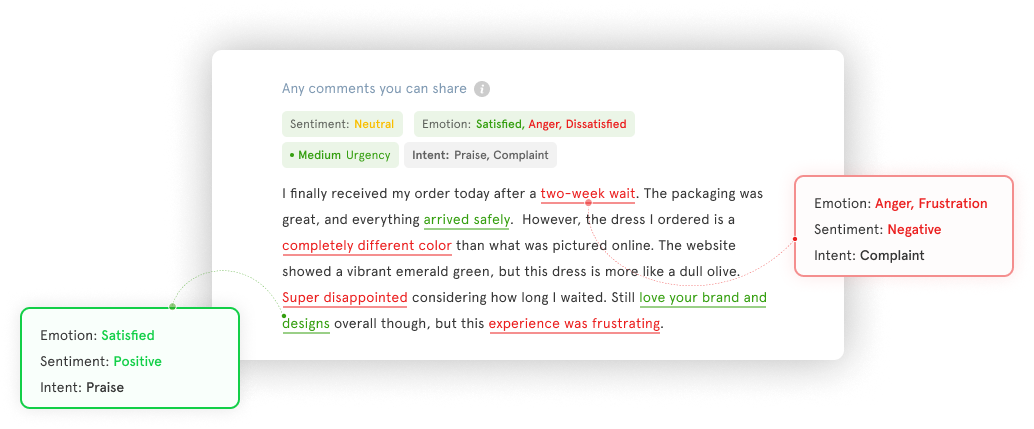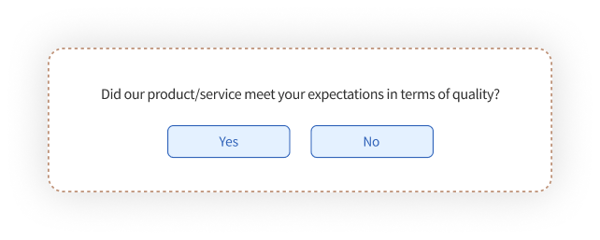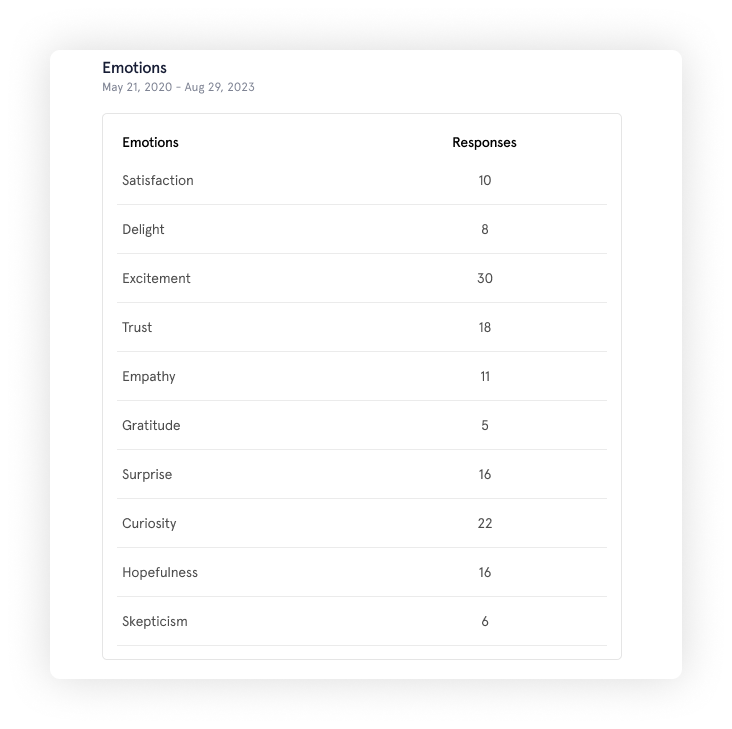Emotions are integral to how humans feel and react to things around them.
Several brands like Apple, Nike, Coca-Cola, and Dove have been capitalizing on human emotions to connect with their customers, and are naturally succeeding at it.
True, emotions and business are tightly knitted.
So much so that 93% of businesses agree that customers who feel emotionally connected to their brand are more likely to become their buyers.
While emotional marketing and emotional branding are popular techniques incorporated by tons of brands, one very effective way to leverage emotions for business success is by identifying emotional motivators in feedback through emotion detection.
What is Emotion Detection?
Emotion detection is an advanced technique that deploys advanced technologies like Machine Learning, Natural language Processing, Computer Vision, Image Processing, and many more to identify hidden emotions. These could be frustration, bubbling excitement, or even unspoken disappointment.
In layman's terms, emotion detection is the process of detecting hidden emotions like excitement, anger, satisfaction, frustration, confusion, thankfulness, and more in human expressions.
💡Gartner describes emootion detection as the task of recognizing a person’s emotional state — for example, anger, confusion or deceit across both voice and nonvoice channels.
Humans are complex creatures; our emotions are not just internal feelings but also external expressions. Verbal signals serve as critical elements for expressing emotions within the text. This complexity of human emotions, especially due to sophisticated verbal communication, makes emotion detection a fascinating yet challenging field.
For several years, industries like retail, streaming services, advertising, hospitality, and others have used emotional recognition from facial expressions to direct their efforts and strategies.
Hotels have been training their staff to be fully aware of the facial expressions of guests while interacting with them to identify their emotions. Retailers have been leveraging facial emotion recognition to gauge customer response to different displays or product placements. Call centres or chat supports have been utilizing emotion detection to identify frustrated or angry customers.
The applications have been many.
However, with advanced technologies gaining the ability to identify emotions without human intervention, conventional models are becoming obsolete.
Today, businesses can deploy a sentiment analysis tool to extract emotions hidden behind the feedback that they share.
Emotion detection in written text, a captivating field within Natural Language Processing (NLP), seeks to decode emotions embedded in the text. Imagine pouring your feelings into a diary and the diary being able to detect emotions you’ve expressed!

Based on reflected emotions, emotion detection models classify textual content. They interpret complex human feelings such as satisfaction, frustration, and excitement.
These models aspire to accurately determine emotional states from textual data, offering insights into the nuanced emotional landscape of human interaction through emotion detection from text.
Decoding Emotions in Text: Detectable Emotion Types
Emotions, being multifaceted, can be segmented into numerous categories. According to psychologist Paul Eckman, there are six basic emotions that help us identify emotions in ourselves and others:
- Happiness
- Sadness
- Disgust
- Fear
- Surprise
- Anger
But emotions are not just black and white. All major emotional words can be further categorized as positive, negative, or neutral, illustrating a more general sentiment toward a stimulus.
.png?width=1466&height=900&name=Positive%2c%20negative%2c%20neutral%20Emotions%20in%20emotion%20detection%20(2).png)
Positive Emotions 😀
Positive emotions evoke feelings of happiness, satisfaction, and optimism. They uplift mood and enhance well-being, fostering joy, gratitude, and enthusiasm. Positive sentiment can strengthen relationships, boost resilience, and promote a sense of fulfillment and contentment in individuals.
- Joy: Intense happiness and pleasure.
- Delight: Great enjoyment and satisfaction.
- Excitement: Anticipation of something pleasing or stimulating.
- Loyal: Feeling faithful and committed to someone or something.
- Trust: A belief in the reliability and honesty of someone or something.
- Anticipation: Eager expectation of something enjoyable.
- Enthusiasm: Strong excitement and positive energy.
- Curiosity: Desire to learn or know something.
- Appreciation: Recognition and gratitude for someone or something good.
- Relief: Feeling relaxed and happy after stress or anxiety.
- Hopefulness: Positive expectation of good things to come.
- Empathy: Ability to understand and share the feelings of another.
- Nostalgia: Sentimental yearning for the past.
- Pride: Feeling of satisfaction and pleasure in someone or something you are associated with.
- Gratitude: Feeling thankful and appreciative for someone or something good.
Negative Emotions 😠
Negative emotions encompass feelings of distress, discomfort, and dissatisfaction. Any such negative opinion or emotion arises from perceived threats, disappointments, or conflicts, triggering reactions like anger, sadness, and fear. While unpleasant, negative emotions serve as signals for addressing challenges, fostering growth, and maintaining emotional balance.
- Frustration: Annoyance and irritation due to an obstacle or difficulty.
- Disappointment: Sad emotions or dissatisfaction because something did not happen as expected.
- Surprise: Sudden feeling of wonder or astonishment
- Sadness: Feeling of unhappiness and sorrow.
- Disgust: Strong aversion or dislike towards something considered unpleasant.
- Anger: Strong feelings of displeasure and hostility.
- Fear: Feeling of apprehension or anxiety due to a perceived danger.
- Impatience: Feeling of annoyance due to having to wait.
- Skepticism: Doubt or disbelief towards something.
- Anxiety: Feeling of worry, nervousness, or unease.
- Boredom: Lack of interest or stimulation.
Neutral Emotions 😕
Neutral emotions lack strong positive or negative valence. They often arise in situations where individuals may feel indifferent, undecided, or uncertain. While not inherently impactful, neutral emotions can precede shifts in mood or serve as a state of equilibrium before experiencing more pronounced emotional states.
- Confusion: Feeling perplexed, puzzled, or uncertain due to lack of clarity or understanding about a situation or information.
- Indifference: Experiencing a lack of interest, concern, or enthusiasm towards a particular subject or event.
- Apathy: Feeling a lack of motivation, interest, or emotional response towards activities or events that would typically elicit a reaction.
- Boredom: Experiencing a lack of engagement, stimulation, or interest in one's surroundings or activities.
Nonetheless, confining human emotions to merely these categories would be unjust. Within the broad categories of positive, negative, and neutral, specific emotions like satisfaction, delight, frustration, and excitement can be detected and classified. It’s like peeling an onion, with layers of emotions waiting to be discovered.
Additional Dimensions in Emotion Recognition
Intensity: Can the text convey the strength of the emotion (e.g., mild annoyance vs. furious rage)?
Target: Who or what is the emotion directed towards (e.g., self, product, company)?
Motivation: Can the text reveal the underlying reason behind the emotion (e.g., dissatisfaction with service, excitement about a new feature)?
What is the importance of detecting emotions in customer feedback?
While customer feedback offers valuable insights, understanding the emotions behind those words unlocks an even deeper level of knowledge. Emotions play a crucial role in shaping customers' experiences and perceptions.
By detecting and analyzing emotions in customer feedback through text based emotion recognition, businesses can gain a comprehensive understanding of how their products or services impact their customers on an emotional level.
Emotions provide valuable context to customer feedback. They reveal the true motivations, preferences, and pain points that customers may not explicitly express.
Detecting emotions in customer feedback also enables businesses to segment and personalize experiences. By grouping customers based on their emotional responses, businesses can tailor their communication and offerings to meet individual needs.
Here's why detecting emotions in feedback is crucial for any business:
#1. Emotional Recognition Helps Them Go Beyond Words
Surface-level analysis often falls short: Ratings or "yes/no" answers like the following question don't tell the whole story.  Emotion analysis reveals true motivations, preferences, and pain points.
Emotion analysis reveals true motivations, preferences, and pain points.
Identify hidden trends and patterns: Uncover emotional undercurrents across various feedback channels, providing a holistic view of customer sentiment.
Segment and personalize experiences: Group customers based on emotional responses, allowing for targeted communication and offerings.
#2. Enhanced Products and Services with Emotion Detection
Proactive identification of flaws: Understand what evokes negative emotions, informing future iterations and development.
Early issue detection and resolution: Detect emerging problems before they escalate, preventing customer churn.
Prioritize development efforts: Base product roadmap decisions on actual emotional responses and what truly matters to customers.
#3. Boosting Customer Satisfaction and Loyalty
Proactive and personalized service: Anticipate needs and provide relevant support based on emotional cues in feedback.
Improved complaint resolution: Address the root cause of emotional dissatisfaction, building trust and loyalty.
Measure and track emotional sentiment: Monitor overall customer satisfaction over time and identify areas for improvement.
Additional Benefits
Reduced costs: Proactive issue detection and prevention lead to lower customer support costs.
Increased efficiency: Automating emotion detection saves time and resources compared to manual emotion analysis.
Competitive advantage: Gain deeper insights into customer emotions compared to competitors.
Overall, detecting emotions in customer feedback is of utmost importance for businesses. It goes beyond surface-level analysis and provides a deeper understanding of customer experiences and sentiments. By leveraging emotion detection techniques, businesses can unlock valuable insights, enhance their products and services, boost customer satisfaction and loyalty, and ultimately gain a competitive edge in the market.
How is Emotion Recognition Beneficial to Businesses?
Emotion recognition offers several benefits to businesses across various industries. It empowers businesses to create more meaningful and personalized experiences for customers, improve operational efficiency, and drive competitive advantage in today's dynamic marketplace.
Here are some of the key benefits of emotion detection and recognition for businesses across various industries and scales:
- Improved Customer Understanding: By detecting and analyzing emotions in customer feedback, businesses can gain a deeper understanding of their customers' needs, preferences, and pain points. Emotions provide valuable context that goes beyond surface-level feedback analysis and opinion mining, helping businesses uncover hidden trends and patterns in customer sentiment.
- Personalized Experiences: Detecting emotions in customer feedback allows businesses to segment their customers based on their emotional responses. This segmentation enables businesses to tailor their communication and offerings to meet individual needs, providing personalized experiences that enhance customer satisfaction and loyalty.
- Enhanced Product Development: Emotion detection, fueled by opinion mining, helps businesses proactively identify flaws and issues in their products or services. By understanding what evokes negative emotions in customers, businesses can make informed decisions for future iterations and development, ensuring that their offerings meet and exceed customer expectations.
- Early Issue Detection and Resolution: Emotion recognition enables businesses to detect emerging problems before they escalate, preventing customer churn. By identifying and addressing the root cause of emotional dissatisfaction, businesses can resolve issues promptly and effectively, ensuring customer satisfaction and loyalty.
- Competitive Advantage: Emotion detection provides businesses with a competitive edge in the market. By gaining deeper insights into user emotion compared to competitors, businesses can better understand and meet their customers' needs, ultimately positioning themselves as leaders in their industry.
- Cost Reduction and Efficiency: Proactive issue detection and prevention through emotion recognition can lead to lower customer support costs. By automating emotion detection, businesses can save time and resources compared to manual analysis, increasing efficiency and streamlining operations.
- Improved Customer Satisfaction: Emotion recognition allows businesses to provide proactive and personalized service to their customers. By anticipating customer needs and providing relevant support based on emotional cues in feedback, businesses can enhance customer satisfaction and build strong customer relationships.
- Measurement and Improvement: Emotion recognition helps businesses measure and track emotional sentiment over time. By monitoring overall customer satisfaction and identifying areas for improvement, businesses can continuously enhance their products, services, and customer experiences.
- Proactive Customer Service: Emotion recognition enables businesses to anticipate and address customer needs and concerns in real time. By detecting emotions during customer interactions, companies can provide timely support, resolve issues efficiently, and prevent customer dissatisfaction.
In conclusion, emotion recognition is highly beneficial to businesses as it provides a deeper understanding of customers, enables personalized experiences, enhances product development, detects issues early on, gives a competitive advantage, reduces costs, improves efficiency, boosts customer satisfaction, and allows for continuous improvement.
By leveraging emotion detection techniques, businesses can unlock valuable insights and drive success in their respective industries.
What are the Techniques Employed in Emotion Detection?
Generally, emotion detection is performed on the facial expressions of a person. Hence, it uses image processing through computer vision to detect emotions.
However, since we are discussing ways to detect emotions and sentiments in text feedback, there are different advanced text analytics and sentiment analysis models deployed to make things work.
-
Sentiment Analysis: Classifies text as positive, negative, or neutral using predefined lexicons or machine learning models.
-
Emotion-Specific Lexicons: Dictionaries containing words associated with specific emotions (e.g., "excited," "frustrated").
-
Machine Learning Approaches: Analyze patterns in text and context to identify emotional cues. These can include:
-
Linguistic features: Word choice, punctuation, sentence structure.
-
Part-of-speech tagging: Identifying nouns, verbs, adjectives, etc.
-
Topic modeling: Discovering underlying themes and sentiments.
-
N-grams: Analyzing sequences of words to capture sentiment shifts.
-
-
Deep Learning Models: Neural network architectures such as Recurrent Neural Networks (RNNs), Convolutional Neural Networks (CNNs), and Transformer models (e.g., BERT) for learning complex patterns in text data and capturing contextual information.
-
Aspect-based Sentiment Analysis: Identify specific aspects or topics mentioned in customer feedback (e.g., product features, customer service) and analyze sentiment associated with each aspect separately.
Emotion Recognition vs. Sentiment Analysis
A function that strives to associate verbal signals with specific inner emotions is involved in emotion recognition in text. It’s like having a compass that points to the exact emotion being expressed. However, this mapping function is complex. Just like the lack of a universally accepted ontology of emotions, there is no perfect map to our emotions.
Lexicon-based approaches to emotion detection involve identifying emotion-indicative words within texts. However, this method of emotion analysis encounters challenges due to the ambiguous association of many words with specific emotions. For instance, the word ‘blue’ could mean sadness or could just refer to a color.
On the other hand, accurate sentiment analysis in natural language processing gauges the overall polarity of text, whether it’s positive, negative, or neutral. Imagine it as an emotional thermometer, measuring the overall ‘temperature’ of a text. However, unlike emotion detection, sentiment analysis doesn’t strive to pinpoint distinctive human emotions like happiness or sadness.
Challenges and Limitations in Emotion Detection
Despite their power, deep learning and machine learning models often find it challenging to accurately interpret emotions in text data, particularly when dealing with:
- Sarcasm
- Irony
- Idioms
- Metaphors
- Figurative language
It’s like trying to decode a secret language, where words hold different meanings in different contexts.
The challenge of dealing with homonyms in text-based emotion analysis is yet to be effectively resolved by current deep learning approaches due to their reliance on word-level context. Imbalanced classes in emotion classification datasets pose a challenge for deep learning performance, making accuracy an unsuitable metric on its own.
The use of pre-trained embeddings in emotion detection can lead to poor performance on texts varying significantly from the training corpus and difficulty handling out-of-vocabulary words or sentences. Hybrid models that weave together rule-based systems and deep learning can mitigate some of these weaknesses and improve emotion detection accuracy.
Ethical Considerations
Though the world of emotion detection is captivating, it is not without its ethical considerations. The technology involves the analysis of personal and potentially sensitive data, leading to privacy concerns. Without their knowledge, individuals’ raw facial expressions and micro-expressions can be translated into data for emotional analysis.
There is a potential for emotion detection technology to be misused, such as through manipulation or influence, particularly when dealing with vulnerable populations like the elderly. Therefore, it’s essential that safeguards and ethical guidelines are put in place to protect the privacy and interests of individuals.
Emotion detection technology presents several ethical considerations and challenges that need to be addressed. Concerns around data collection and privacy can arise when leveraging emotion analysis for enhancing business performance. It’s a tightrope walk, balancing the benefits of emotion detection with the need to respect privacy and ethical considerations.
Enhancing Customer Experience Through Emotion Detection
By personalizing services and fostering deeper connections, emotion detection offers opportunities to enhance customer experience. Imagine walking into a store where the staff understands your needs and preferences without you having to utter a word! Zonka Feedback represents a tool for collecting customer feedback and detecting emotions, which aids businesses in enhancing the experience. Technologies deployed in emotion detection allow for a nuanced understanding of the customer and user emotions during interactions, leading to more personalized experiences and services, and can adjust the product to offer a unique user experience.
The successful identification of high-intensity emotions and emotion analysis like feeling valued correlates with increased consumer spend, brand preference, and loyalty, thereby enhancing overall business performance. It’s like having a secret formula to win customer loyalty and boost business performance.
From Data to Actionable Insights
Large-scale datasets, crucial for shaping business decisions and strategies, are generated by integrating emotion detection features into consumer devices. It’s like having a goldmine of data, ready to be unearthed for valuable insights.
The growing market for emotion detection and recognition technology is characterized by strategic business moves such as mergers, acquisitions, and partnerships, reflecting its importance in business strategy. The Emotional Signature framework identifies clusters of emotions that are critical for fostering positive customer experience, leading to improved attention, recommendation, and advocacy.
Emotion detection and recognition software can offer businesses much-needed insight into their customers' true feelings and sentiments. Using the data, businesses can identify the number of responses with a particular emotion. This would help drill down and segment users to identify who are happy, angry, frustrated, satisfied, excited, and more. Based on the type of major emotions detected within the feedback, one can very easily direct their marketing, product development, messaging, and other strategies to ensure customer satisfaction and a seamless customer experience.

In conjunction with other machine learning techniques, sentiment analysis contributes to predicting user behavior and deriving insights into user preferences based on their emotional responses.
Applications & Use Cases of Detecting Emotions from Customer Feedback
Emotion detection is revolutionizing how businesses gain deeper insights from customer feedback. This, in turn, has enabled several businesses to use various emotion models to enhance their experiences.
Here are some real-life examples across various industries:
1. Airlines Using Emotion Detection to Prioritize Services
Airlines can use emotion detection to analyze feedback responses and social media sentiment around cancelled flights. Identifying emotions conveyed in feedback like frustration and anger will allow them to prioritize customer service outreach and offer proactive compensation.
They can even use emotion recognition to analyze call center conversations to detect stress and anxiety in passengers facing delays. Early identification will enable them to provide personalized support and improve communication during disruptions.
2. Retailers Using Emotion Detection To Prioritize Product Improvements & Loyalty Enhancement
Retailers can use emotion analysis to analyze product reviews to identify features causing frustration (e.g., "confusing instructions"). This would help them prioritize improvements and refine user manuals.
They can even track sentiment in social media mentions of their loyalty program. Detecting disappointment with reward structures led them to adjust the program and improve customer satisfaction.
3. eCommerce Platforms Using Emotion Analysis To Boost Sales
eCommerce platforms can analyze the emotions hidden behind customer feedback to identify factors influencing loyalty and purchase decisions. They can analyze survey responses received from eCommerce surveys using emotion detection to recognize excitement towards specific product features but also anxiety about other aspects of the business, for example, return policies. They can then use the insights from emotion analysis to simplify the issues, here, return policies, and highlight relevant features in marketing campaigns, resulting in increased sales and repeat customers.
4. Hotel Chains Using Emotion Detection to Enhance Stay Experience & Satisfaction
In order to uncover the underlying causes of decreasing satisfaction ratings, hotel chains can utilize emotion detection to analyze open-ended feedback from hotel satisfaction surveys. This emotion analysis can reveal the key factors influencing the stay experience, especially what's leading to a negative stay.
In one of the real-life applications, it was revealed that guests were frustrated with the outdated room decor and lack of personalization offered by the hotel. In response, the hotel chain took action by renovating the rooms and implementing guest preference programs, resulting in a significant boost in satisfaction scores.
Using Zonka Feedback for Feedback Collection, Emotion Detection, and Enhancing Experience
Zonka Feedback is a powerful customer feedback tool that allows businesses across various industries to collect feedback and analyze responses to detect emotion. It is powered by artificial intelligence, natural language processing, and machine learning to offer text analysis, sentiment analysis, intent analysis, opinion mining, and several other ways of analyzing customer feedback.
This survey software helps businesses analyze the multiple customer emotions hidden behind reviews and feedback. It helps identify the emotions of the customer expressed while writing a comment. They can analyze the customer’s happiness or sadness with a product, service, brand, or review subject.
Offering custom emotion models, this tool would learn from thousands of text data and can also help detect set emotions from the feedback.
Schedule a demo to learn how it can help you detect customer emotions.











